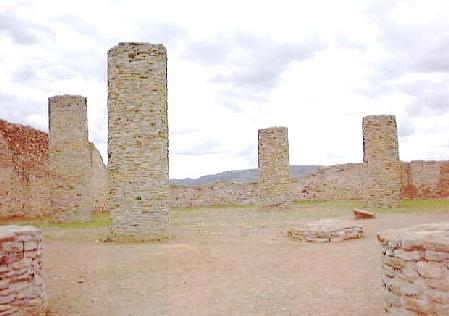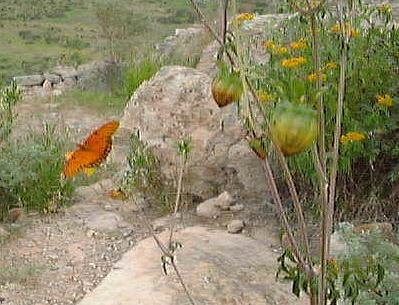
Zacatecas, Mexico
Part three - La Quemada

Statue at the start of the road to La Quemada
Saturday 21st August 1999
From Zacatecas, we took a day trip to the ruins of La Quemada ("The burnt place"), about 55 kilometres from the city. The ruins are approached along a road about a mile long. The setting was described in our guidebook as "fairly isolated" which is a bit of an understatement. The approach road is lined on either side with napales fields (a type of cactus) and the plants look as though they've had a hard time. Our sense of isolation was heightened by the fact that the only person we saw on the way to the ruins was a farmer in traditional costume (including a small sombrero) riding a donkey through the cactus fields. To make matters worse, the road was swarming with crickets, larger than the European variety and coloured a garish red that seemed to have been designed to be repugnant. There were dead crickets all over the road, and live crickets either eating the dead ones or copulating. This was not a pleasant sight; although the scenery was beautiful, we spent most of our time en route to the ruins trying to avoid the jumping, crawling, rotting and fornicating insects!
The statue in the picture above represents an old Aztec legend, based on the apparently mistaken assumption that La Quemada was the site of a famous event in Aztec history - during their wanderings before they settled in the Valle de Mexico, at a place called Chicomostoc, the Aztecs came across an eagle on a cactus eating a snake. In their mythology, this apparently meant that they were to stop their wanderings and settle down. In fact, more recent excavations and studies have shown that this was probably not the case, and the site was occupied between 500-900 AD.

The "Hall of Columns", La Quemada
The first building you see as you enter the site is called the Hall of Columns. Twelve brick columns, each around 15-20 feet high, stand in rows surrounded by the remains of once-impressive walls. This whole structure sits atop a massive stone structure which is so cunningly built into the hillside that at times it is difficult to tell where the wall begins and the hill ends. The columns once supported a wood and adobe brick roof, burnt remains of which were found scattered on the floor of the hall. At its peak, this was one of the largest roofed buildings in Mesoamerica, and must have been an imposing sight.

More La Quemada ruins
The whole La Quemada site is enormous. To give a sense of scale, on the right of the picture above, there is a line sticking up just above the first rise in the wall. The line is in fact one of the guides. The site sits on top of a hill with two summits, and its easy to see when you get up there why the builders chose this location - from the highest point, you can see for miles all around, and the inhabitants of this site could have controlled the whole valley. In fact, there are a number of other sites scattered around the valley where remains from this period have been found, and it has been suggested that the bulk of the population lived most of the time in the valley below, while La Quemada would have been a religious and defensive site.

Our first pyramid, with the view into the valley below
Recent studies have shown that "The Citadel", which sits at the highest point of the site, was in fact a form of observatory. The sides of the central square structure are aligned along the four cardinal points, while patient observation has shown that certain structures are positioned so as to be highlighted at astronomically significant times, such as sunrise on the summer solstice. This lends support to the theory of the site as a religious and defensive centre for the valley as a whole. One other feature of the site which is supposedly unique for Mexico is the fact that from the base, two ancient paved roads lead off along the valley floor to other locations. Pre-modern ploughs were unable to break through the paving, and so this is perhaps the only remaining ancient paved road extant in Mexico.

La Quemada is also home to a number of beautiful butterflies
Previous | Mexico index | Travel index | Family history | Romany | Main index